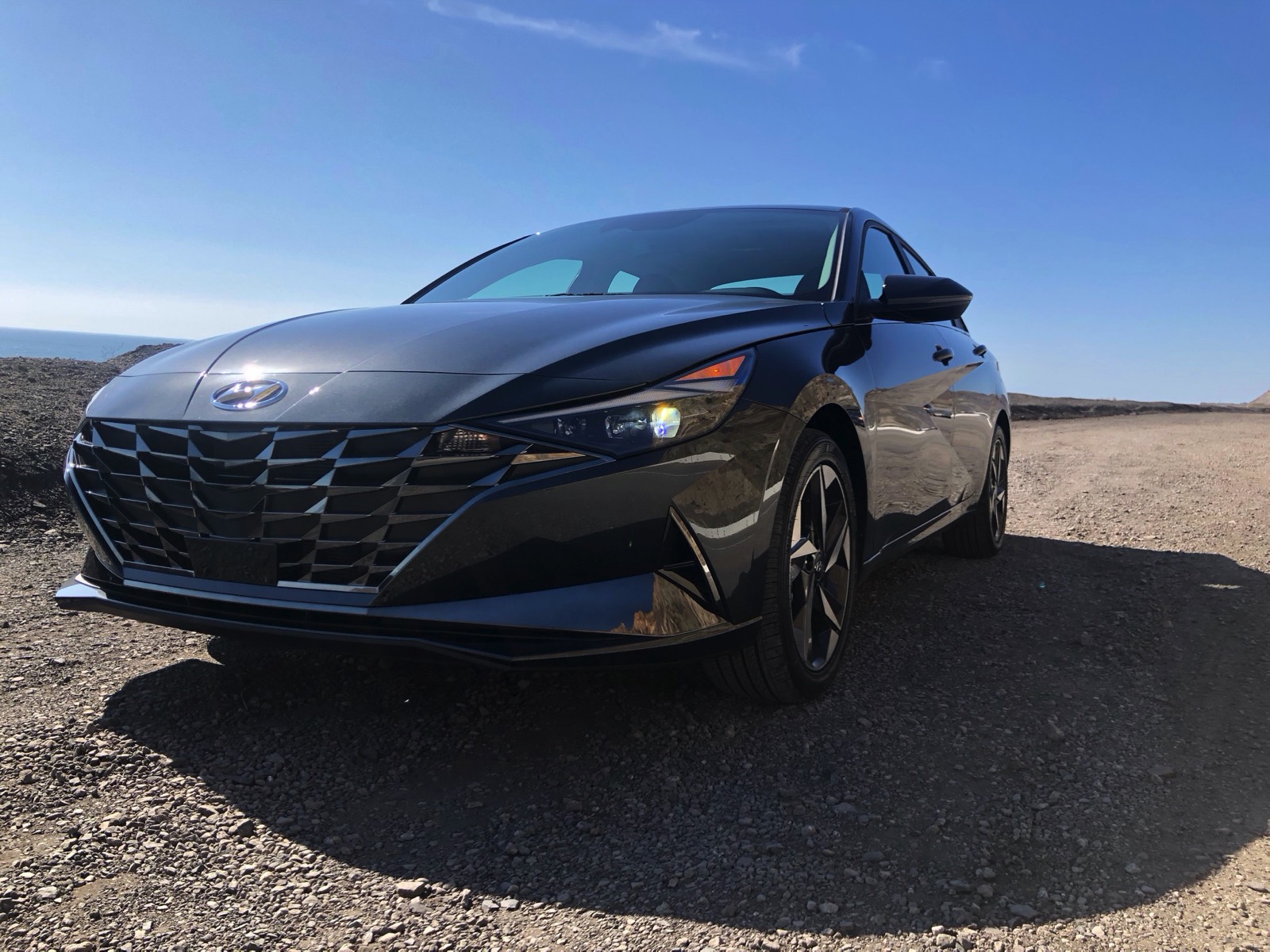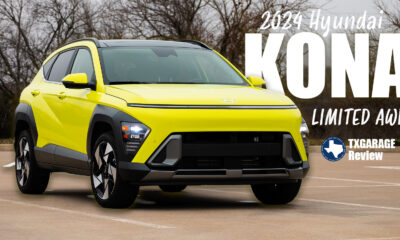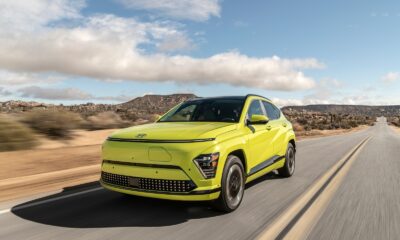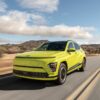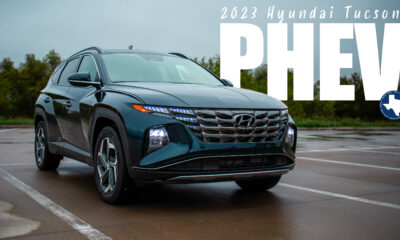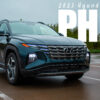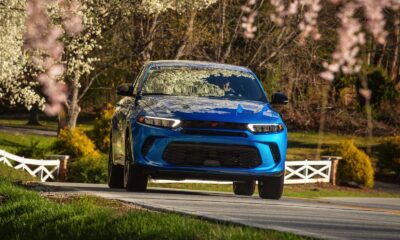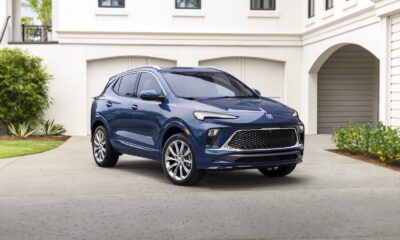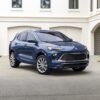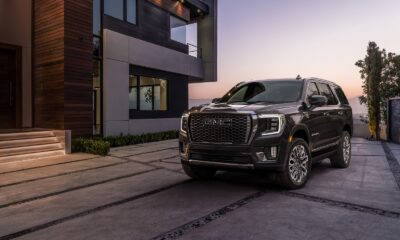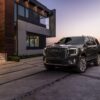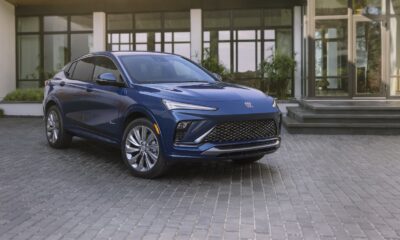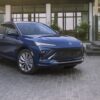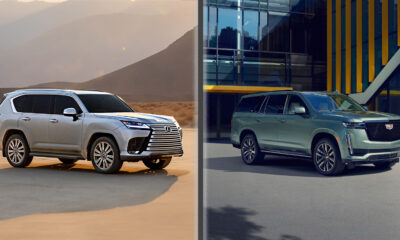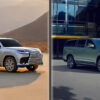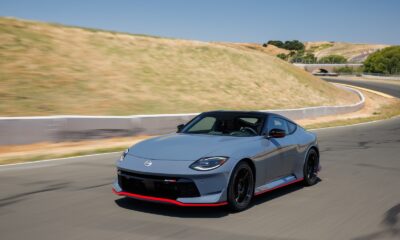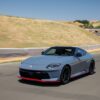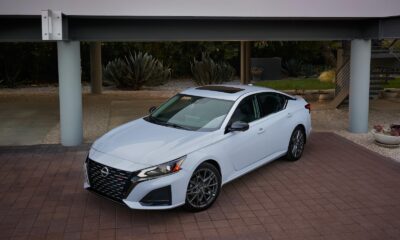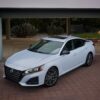Car Reviews
2021 Hyundai Elantra
In its first major media event since the start of the pandemic, Hyundai put its focus on its best-selling car—and one of its best-selling models overall—the Elantra compact. There’s a lot of big news for Elantra, as the all-new 2021 model marks the seventh generation of the venerable nameplate, and Hyundai has a variant of the car for seemingly every kind of buyer.
What is this vehicle?
The Elantra is Hyundai’s compact car, though for much of the nameplate’s life it has been ahead of the competition in terms of size, with more interior volume than most of the rest of the segment. That’s still true for this new model, and the car has grown a bit to maintain that advantage, so the Elantra now has a bigger footprint than most of its competition, though it has actually come down in height, with an emphasis on coupe-like design.
The Elantra lineup grows to include an efficient hybrid model and a sport-focused N-Line trim, so it’s able to serve more market segments than before. And the improvements benefit the whole lineup, so we’re looking at a general step-up in-car goodness, at a time when CUVs, like the brand’s upcoming all-new Tucson compact, are getting most of the attention.
Competition is brutal in this segment, with Honda and Toyota so dominating sales that they’ve starved the domestic nameplates to death, with Ford Focus, Chevy Cruze and Dodge Dart leaving the market completely. In fact, the second-place Corolla still outsells the third-and fourth-place vehicles combined.
That number three spot goes to Hyundai, though, and it’s a testament to the great work that Hyundai has done building the Elantra nameplate that it can even share a podium with the Civic and Corolla. The Elantra has continually provided great value in the segment, while advancing its design game steadily, with recent models presenting a highly attractive and sophisticated package to compact buyers.
Still, Elantra has taken one of the biggest sales tumbles for the brand over the past year, falling 3.5 times as much as Tucson, and getting uncomfortably close to its rival,the Nissan Sentra. So this redesign comes at a good time to reinvigorate the Elantra nameplate, and see if Hyundai has the juice to truly compete with Honda and Toyota in the segment.
Who is this vehicle for?
While crossovers are the new normal, there are still plenty of people for whom a sedan is the default vehicle type. It’s fairly sleek, fuel-efficient and reasonably spacious, even if you’ve got some luggage to take along, and those descriptors definitely apply to the redesigned Elantra.
In many ways, the choice between a sedan and a utility these days hinges on personal preference more than personal characteristics. If a styling statement is a big part of your vehicle purchase, the lower-slung sedan style might be for you. And that choice will also yield dividends in the handling department, with a vehicle that’s generally more fun to drive and more planted in its manners than a comparable crossover.
Hyundai doubled down on its bet that style is paramount for sedan buyers, and as often is the case, the brand’s cars lead the way into the next styling frontier. That’s especially true with the brand’s new design language, which they’ve dubbed Sensuous Sportiness, and which debuted on last year’s all-new Sonata. For Elantra, the brand takes in some ways a bigger leap, and perhaps one of faith that shoppers will see the more overtly stylized details of the Elantra—like the elaborate geometry of its flanks—and feel it resonates with their taste.
Hyundai is fully leaning into its computer-aided design tools, with a concept called parametric design that turns more on the tweak of an equation than the twitch of a wrist to define the styling theme of one of the vehicle’s design elements. Perhaps the most prominent example is the new Elantra’s grille, with its complex geometric pattern of rhomboid sections formed by the interlocking of various triangles.
The Elantra is no shrinking violet from the rear-view, with a distinct angular concavity that’s crowned by a trunk lid with incredibly complex shaping. And the width of the car—nearly 2 inches broader than a Corolla—is accentuated by the horizontal layout, particularly the “flying H” signature of the LED tail lamps.
It’s also nice to spend time indoors, with Elantra’s cabin offering nice upgrades from the previous generation, even if the back seat still won’t be the favorite place for older kids you might be shuttling around to practice, especially if it’s high school basketball practice. If that’s the case you might want to check out Hyundai’s CUVs, like the Venue or Kona subcompacts, or even the upcoming 2022 Tucson.
Why is this vehicle important to you, the buyer?
With the compact car segment whittling down to fewer models, dominated by the two leaders, it’s healthy for there to be other strong entries, especially from a brand with as much heft and momentum as Hyundai, to challenge the duopoly.
The Elantra raises the bar in terms of refinement, including interior design, and Hyundai’s infotainment screen continues to be one of the industry’s leaders, pushing the graphical edge forward. And this tech is surrounded by a dash and controls setup that is verging on the luxurious, comparing competitively with the likes of Volkswagen and Mazda in terms of interior class.
Hyundai also pushes the envelope in terms of available active safety equipment, and its SmartSense suite of features is getting more and more capable, verging on the talents of some more well-known systems marketed as autonomous (though not quite there yet). Every car gets the all-important automatic emergency braking—”Forward Collision-Avoidance Assist (FCA) with Pedestrian Detection” in Hyundai speak—as well as Lane Following Assist (LFA) to keep you centered in your lane, and even Driver Attention Warning (DAW) to make sure you’re alert.
Optionally you can add blind-spot warnings and active cruise control, which combines with the LFA to form Highway Driving Assist (HDA), and which gets you close to autonomous capability. So you get a lot of letters with the Elantra, and they’re good news.
Interesting facts about the Elantra and Hyundai!
- The Elantra is Hyundai’s best-selling model, with over 13 million sold around the world since its introduction.
- The 2019 Elantra got a facelift that made it look like a whole new car, but it was mostly carry-over.
- The Elantra is available with not one, but two 10.25” screens on the dash—an infotainment screen at the top of the center stack and a digital gauge cluster—both of which are set behind a single pane of glass with a curve at its center which can get replaced at www.glass.net.
- The shape of the trunk lid is only possible with a plastic skin over the metal structure, which Hyundai adopted in order to avoid compromising its design vision.
What Impressed Us / Top Likes:
Interior Detailing
The Elantra is very impressive inside, with an upscale bill of materials, especially in the Limited model we sampled. The shifter feels like it’s been pulled from an Audi, and the interior is fitted with a fair bit of what feels like real metal accents, including the wheel and many of the buttons you’ll have your fingers on most often.
There are plenty of physical buttons for those who don’t want to do everything through a touch-screen, but Hyundai has managed to keep the dash from feeling to cluttered, making good use of its impressive screens.
The interior lighting was also upscale, with a line of color stretching across the dash that really made the interior pop at dusk.
Not only did the Qi wireless charging pad keep my phone in place even under the most spirited driving conditions, but it also comes with built-in air cooling, which is particularly excited for someone who has a metal phone case that tends to heat up a bit on wireless chargers.
The Elantra also has the distinction of being the first in its class to have wireless Apple CarPlay and Android Auto. It’s a bit confusing, though, since it was standard on the smaller, dinkier screen you get with the lower trims, but when it came to the big, beautiful 10.25” screen, I had to be hardwired in.
ADAS Features
The Elantra has sophisticated Advanced Driver Assist Systems, as mentioned previously, and they work well on the whole. Smart Cruise Control is fairly smooth in following the car in front of it, though it does have a bit of an issue with the transition between two different lead vehicles to follow.
The Highway Driving Assist system was good enough to be able to offload the entire control task to the vehicle for significant stretches of freeway, though it’s not mature enough yet to call it a truly autonomous, among the likes of Tesla Autopilot, Cadillac SuperCruise or Nissan ProPilot Assist, since even a curve that’s a little too tight requires steering input from the driver.
Hyundai Digital Key
With the MyHyundai app, the Elantra turns your cell phone into your car key, so that’s one less thing to throw in your pockets or purse. You can do everything you can with your key and more, and it can be tapped on the door handle to unlock the car and put into the wireless charger to start it.
It can also handle different driver profiles based on different phones and pre-condition the carby starting it and setting a temperature. And it uses both Bluetooth and NFC tech, so it’s quicker to interact with the car than Tesla’s phone key tech, which has to connect with the car through WiFi. The downside is that you can’t just keep your phone in your pocket the way you do with your car key. It has to be held near the door handle and then placed into the charger to work.
Chassis Tuning
While Elantra has never been one of the sportiest entries in the segment, it always offers a great combination of refined manners and confidence. This new model feels reasonably upscale, with nicely weighted steering and confident, smooth brakes. Body roll is well controlled, but grip feels about average for the segment, if not on the lower side.
Items to Make Better (Least Favorite Things):
Voice Commands
Hyundai was very excited to have us try out the voice commands for the Elantra’s new DynamicVoice Recognition System. During our testing, it performed much like every other factory infotainment voice command system: an unmitigated disaster. Sure, you can say something like“Cool down,” and the system will cheerily tell you it’s turning on the A/C and setting the temperature to 64 degrees. But what if you want a different temperature, or to turn the system off cause you’re opening the windows?
Hyundai gave us a sheet of commands to try that seemed like they may point to an intuitive understanding of what you wanted to get done, and even bragged about its “natural-language voice-recognition system with Speech-to-Meaning® and Deep Meaning UnderstandingTM technologies powered by Houndify.” But if I gave it a command that differed slightly from what was on the sheet, it failed. It even failed sometimes when I gave it exactly the right command, but the cabin was a bit too noisy (like turning off the A/C after opening the windows).
I asked it to point me to the nearest Starbucks, and it pointed me to locations that were behind me. So I corrected what I thought was my mistake, and asked for the next one on my route, and it was mystified. At one point when I gave up on the voice recognition system, I tried to enter something manually, and found that it told me I could only enter a destination by voice while I was moving. Useless.
But don’t feel bad, Hyundai. I’ve been told I was gonna be blown away by a new voice recognition system many times, and it’s never been true. It remains the case that the only systems I know of that are worth a darn are Mercedes’ MBUX system, which can interpret a staggering number of commands, and Tesla’s voice recognition system, which can recognize a shockingly broad array of local points of interest. If one were to combine the two, one might have a system that actually works. This one does not.
Potential ADAS Confusion
While some of the Elantra’s ADAS features are quite impressive, it’s a system that has the potential to create confusion. Hyundai’s system is intended to act as a driver aid that runs in the background while the driver remains in full control. But the system is so good that it can lull you into a false sense that the vehicle has control of the situation. The suddenly a curve is too tight, and you’re veering into the next lane.
If the vehicle is going to do that much for you, it had better be prepared to take it all the way, because it’s way too easy for a driver to become distracted when it’s possible to take your hands off the wheel for extended periods of time. The car does remind you to keep your hands on the wheel, but I was able to divert my attention for the better part of a minute before it started to scold me.
The active cruise also became confused when switching into a new lane, especially near an intersection. More than once I switched lanes as I was pulling up to a red light, and the car started to accelerate towards the stopped vehicle in the new lane. Another reminder that these systems are not going to do all your thinking for you, even if at times they seem capable of it.
Random panel to left of cluster
Hyundai told us that the panel to the left of the instrument cluster would be home to a new drive mode selector in the upcoming N-Line variant of the car. And there’s the potential for a future magnetic accessory mount, which would be super cool.
But right now, it’s nothing. It’s just a gloss-black panel with a circle and a line on it. And it’s kinda strange. The only thing it actually does is remind you of what you don’t yet have—and may never?—and provide a nice balance for the look of the infotainment screen on the other side of the cluster. I would have asked if that magnetic mount feature would be a possible retrofit if and when it’s actually introduced for the Elantra in the future, but I got the feeling their crew was pretty tired of my questions about it.
Hybrid Variant
Hyundai is also introducing a hybrid model, which uses the hardware from its Ioniq dedicated electrified model, but tunes it in a way that’s more usable in everyday life. I got over 50 mpg in that model, and that’s without even trying to baby the car and wring out the max efficiency, in contrast to the roughly 35 mpg I got with the Limited model I drove, though that likely would have been closer to 40 if I’d driven it without malice, as I did the hybrid.
The hybrid system read-out is pretty intuitive, with a power meter that takes the place of the tachometer, and tells you the state of charge of the onboard battery and whether that battery is taking on energy from braking or coasting, or discharging it to help with acceleration.
The transitions between the internal combustion engine being on or off was pretty undramatic, and the powertrain seemed a good compromise between power and efficiency. You’re not winning any drag races with this thing, but it can get out of its own way. And the powertrain was reasonably refined in its noises, though it did get a bit thrashy when the car was going up a steep grade and the engine kicked in to help out.
N-Line Variant
Hyundai is expanding its brand lineup in a similar way to that of the luxury leaders, creating a ladder of trim branding that accentuates the marque’s sporty intentions. The sporty theme is brought to you by the letter N, which for Hyundai pays tribute to both its Namyang engineering facility in South Korea, and the famous Nurburgring in Germany, the test track where Hyundai does much of the tuning.
The progression starts with the N-Line, which is a sporty upgrade form the basic SE and SEL trims, though it sits below the top-line Limited trim. From there you can jump to an actual high-performance variant, the N, which will be only the second such model from Hyundai, following the Veloster N.
The N-Line upgrades the powertrain, from the base model’s 2.0-liter four to a turbocharged 1.6-liter. Power goes from 147 hp and 132 lb-ft of torque to 201 hp and 195 lb-ft, and it makes the car more fun to drive, and a better match for its upgraded suspension, which on the N-Line includes a multi-link independent rear.
It comes with either a 6-speed manual with summer tires on its 18” wheels, or a 7-speed dual-clutch auto with all-seasons. The manual model I drove was fun, but the clutch engagement point was a bit vague, and it required some getting used to before upshifts were as smooth as one would hope. Also a bit vague in terms of its feedback was the steering wheel, which had nice weighting, but didn’t really communicate a whole lot about road and grip conditions.
The interior on the N-Line was a nice upgrade, with red stitching galore, and a special 3-spoke wheel (it has this advantage over the Sonata N-Line, which shares the basic Sonata’s 4-spoke number, which isn’t what most performance buyers want). This wheel looks great on the Elantra N-Line, and the shifter looks sharp as well, with its red stripe.
Unfortunately, with the N-Line sitting below the Limited, it’s impossible to get this model with the upgraded display screens, which seems like a miss for the brand. The luxury brands that Hyundai is seeking to emulate (like Audi with its S-Line and S trims) allow you to get the upgraded styling and performance with the top-of-the-heap luxury features, so why not Hyundai?
The N-Line also has some exterior styling touches, like its gloss-black mirrors which will be common to all N-Line models across the brand, as well as a gloss-black grille that integrates with the trim’s unique front and rear fascias. And the parametric design is even echoed in an additional touch on the N-Line wheels, on its raised center cap, and nice detail touch.
Hyundai thinks the Elantra N-Line goes up against the VW GTI and Honda Civic Si (when it returns), while the Subaru WRX is closer to the N model, which makes sense given the WRX’s higher performance but lower refinement compared to the GTI.
Segment and Competitors:
The compact car segment has several competitors still in the game, but only the top few sell in significant numbers. The other compacts on the market are:
- Honda Civic
- Toyota Corolla
- Nissan Sentra
- Kia Forte
- Volkswagen Jetta
- Subaru Impreza
- Mazda3
- Volkswagen Golf
Pricing and Availability:
2021 Elantras are hitting dealers now, and the SE model starts at $19,650 plus delivery. The N-Line starts at $24,100, the Elantra’s only manual transmission trim (add $1,100 for the dual-clutch auto), but it won’t hit dealers till a bit later. The Limited starts at $25,450, while the hybrid model, also coming later, comes as an SEL for $23,550 or Limited for $28,100.
Trust me when I say this is a lot of car for the money, especially at the bottom end, though the Limited models line up right on top of Civic’s Touring trim, using Hyundai’s equipment advantage as its value proposition.
For additional specifications and configurators, please go to: https://www.hyundaiusa.com/us/en/vehicles/elantra
or www.car-ED.com to see if the Hyundai Elantra or any other compact car is a good match for you.



